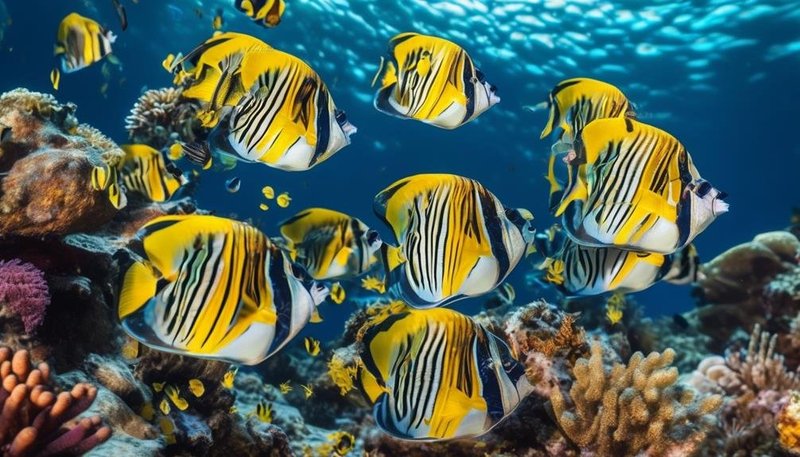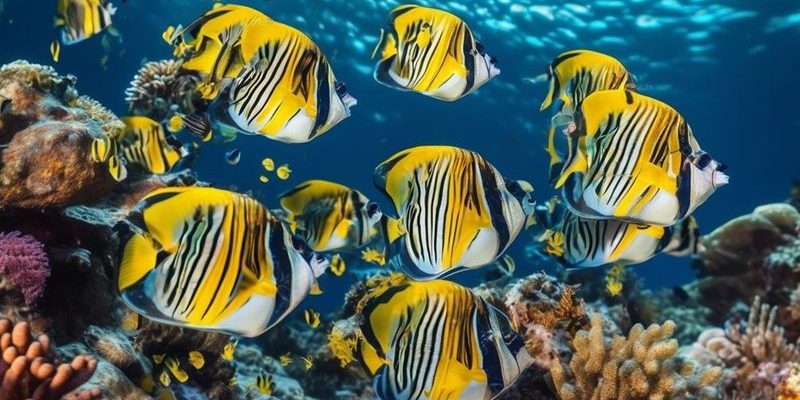
But before we get into the nitty-gritty of tank mate compatibility, let’s take a moment to appreciate what makes the butterflyfish so special. These fish belong to the Chaetodontidae family and are known for their bold colors and unique patterns. Some species are more adaptable than others, making it essential to understand which tank mates can coexist peacefully.
Understanding Butterflyfish Behavior
To determine if butterflyfish can live harmoniously with other fish, it’s essential to consider their behavior. These fish have distinct personalities and tendencies. Butterflyfish are typically known for being peaceful, yet they sometimes display territorial behaviors, especially when they feel their space is being encroached upon. This territoriality can stem from their natural habitat, where they often establish small territories on coral reefs.
When introducing butterflyfish to a new tank, it’s helpful to think of them like guests at a house party. Some might mingle well, while others could clash. You might be wondering how to gauge the right vibes in your tank. Watching how your butterflyfish interact with other species can provide valuable insights.
Commonly, butterflyfish prefer a nicely enriched environment with plenty of hiding spots and open swimming spaces. A well-designed aquarium will not just keep them happy but also reduce any potential conflicts with other fish.
Ideal Tank Mates for Butterflyfish
If you’re considering adding butterflyfish to your tank, the right companions can make all the difference. Generally, fish that are peaceful and don’t share the same habitat preferences often make the best tank mates. Here are some ideal choices:
- Clownfish: These vibrant fish are not only friendly, but they also bring a pop of color to your aquarium. They can coexist with butterflyfish quite well.
- Gobies: Known for their playful nature, gobies appreciate similar reef environments and are unlikely to provoke aggression.
- Damselfish: Some species form a solid bond with butterflyfish, but be cautious as they can also be territorial.
- Cardinalfish: These calm and peaceful fish make excellent tank mates as they are non-aggressive and easygoing.
When considering tank mates, always think about the butterflyfish’s space requirements. Too many similar species can lead to competition over territory, which can result in stress and aggression.
Fish to Avoid with Butterflyfish
While many fish can get along with butterflyfish, there are others that might not be the best match. Choosing the wrong companions can lead to tension in your tank. Here’s a list of fish to avoid:
- Angelfish: They are known to be somewhat aggressive and can take a territorial stance against butterflyfish.
- Surgeonfish: These fish are often more aggressive and could view butterflyfish as a threat.
- Other Butterflyfish: Adding multiple butterflyfish can lead to competition for space, leading to aggression and stress.
- Wrasses: Some wrasses can be overly active and may disrupt the peaceful nature of butterflyfish.
It’s vital to consider not just the species but also the individual fish’s temperament when thinking about compatibility. Sometimes a peaceful species can have a rogue individual that causes problems.
Tank Size and Environment Matters
Before adding any fish, consider your tank size and setup, as this can affect the overall dynamics. Butterflyfish thrive in larger tanks—ideally, at least 75 gallons give them the room they need to swim and establish territories.
A well-planned aquarium environment should include plenty of hiding spots and live rock. Here’s what you can do to create a suitable habitat:
- Live Rock: This acts as both decoration and shelter. It provides a natural environment where your butterflyfish can explore and hide.
- Plants and Corals: Adding soft corals and anemones can create natural barriers, offering security to the butterflyfish while also giving a stunning look to your tank.
- Open Swimming Space: Leave plenty of swimming area to avoid congestion; butterflyfish love to move around freely.
The right environment not only fosters compatible relationships but also ensures that all fish in the tank remain healthy and stress-free.
Introducing New Fish to Your Aquarium
When adding new fish to your aquarium, it’s essential to follow a few steps to ensure a smooth transition for everyone involved. Just like introducing a new friend to an already established group, you want to minimize stress and prevent any territorial disputes.
Here’s a simple way to do it:
1. Quarantine New Arrivals: Always quarantine new fish for at least two weeks to prevent introducing diseases into your established tank.
2. Introduce Slowly: Start by adding the new fish during low-light hours or when the tank is less active. This will help the butterflyfish and other residents adjust.
3. Monitor Interactions: Keep an eye on how your butterflyfish interact with newcomers. Look for signs of stress or aggression.
4. Be Prepared to Separate: If you notice consistent aggression or stress, it may be best to separate the fish.
Patience is key here; it may take some time for fish to find their place in the tank hierarchy.
Feeding and Nutrition for a Peaceful Community
Lastly, maintaining a healthy and varied diet is essential for butterflyfish, as well as for the entire tank. A well-fed fish is generally less likely to become aggressive. Butterflyfish thrive on a diet rich in corals, brine shrimp, and other marine foods that mimic their natural feeding habits.
Make sure to consider the dietary needs of all tank mates. Here are some tips for feeding:
- Variety is Key: Offer a mix of dry and frozen foods to cater to different species’ needs.
- Regular Feeding Schedule: Stick to a consistent feeding routine to keep everyone happy and healthy.
- Observe Eating Habits: Watch how each species feeds to ensure nobody is being bullied and that all tank mates are receiving enough nutrition.
A well-fed tank is less prone to stress, which in turn can minimize aggression and foster a more peaceful environment.
Final Thoughts on Butterflyfish Compatibility
So, can butterflyfish live with other fish? The answer is yes, but with some considerations. They can thrive in a community tank, provided you choose the right tank mates and create an environment that minimizes competition. Keep in mind their behavioral tendencies and environmental needs to ensure everyone gets along well.
Selecting the right companions early on can save you a lot of hassle in the long run. Remember, the goal is to create a harmonious and thriving underwater world, where each fish can enjoy its unique personality and place in the community. By taking the time to research and prepare, you’ll find that keeping butterflyfish—and their friends—is a rewarding and beautiful endeavor.

